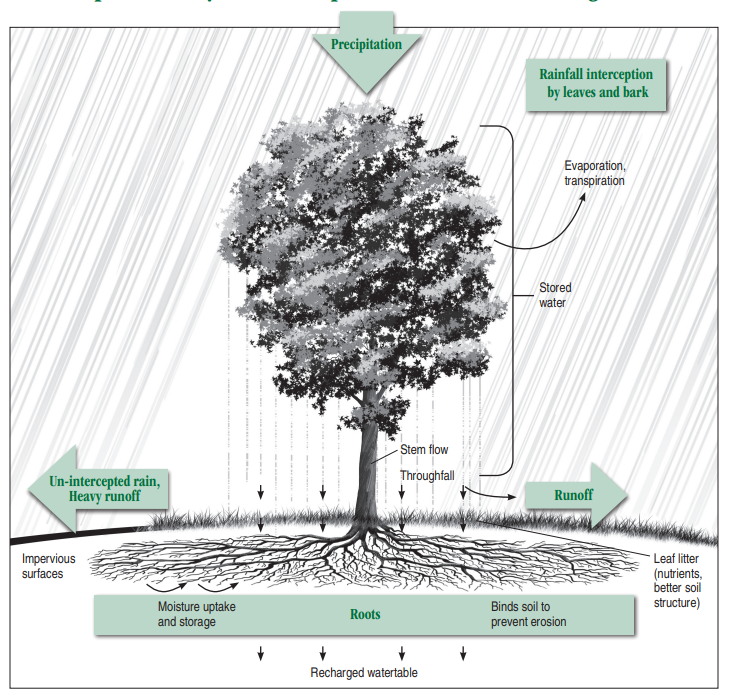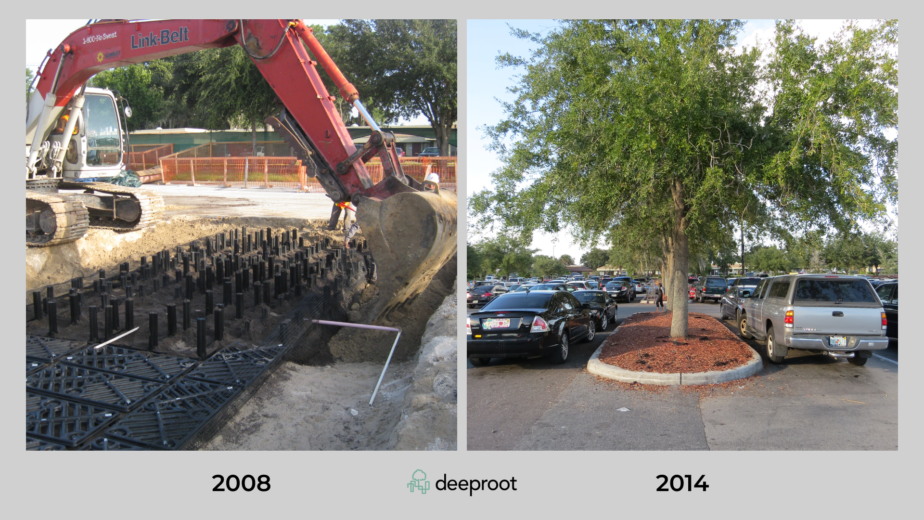In a Nutshell:
- Trees are underrated as integral components of managed urban infrastructure. They have many measurable benefits including stormwater mitigation, pollution reduction, energy conservation, and climate resiliency.
- Infrastructure planning efforts could benefit from appropriately thinking about trees as infrastructure, rather than as impediments to infrastructure construction and maintenance. Simply including the benefits of trees in investment frameworks will improve the efficiency of many infrastructure and utility projects.
- Better utilization of trees as infrastructure often doesn’t require any policy change or new funding. Numerous organizations and individuals already have sufficient authority and funding to better manage our urban forest. They need only the desire, knowledge, and confidence to follow through.
By: Eric Paul Dennis, PE – epdennis@crcmich.org
Trees are highly valued for their aesthetic and cultural attributes. Many cities fund urban forestry services to provide residents with the aesthetic benefits of street trees. These neighborhood beautification efforts are typically weighed against the costs required to plant and maintain the trees, as well as the costs imposed by trees on other infrastructure and utilities. Municipalities rarely consider all the potential benefits of trees.
The objective of this blog is not to offer a complete benefit:cost guide to street trees, but to promote a more holistic way of thinking about our urban forests as critical infrastructure.
To be sure, providing street trees and maintaining an urban forest imposes several costs.
Materials and labor costs approach $1,000 for installation of a typical street tree. Further, newly planted trees are vulnerable and should be monitored and watered while they establish roots. The cost of assuring that trees live past the first few years is substantial enough that many municipalities decline to provide this and instead just replace any that die. This can make financial sense if the only concern is the existence of a tree in a location. Unfortunately, such practices prevent trees from establishing roots and growing into healthy mature specimens, which is when most of the benefits accrue.
Trees that do survive require increasing maintenance costs, both for the tree itself and its effects on nearby infrastructure. Trees must be pruned to remove dead branches, and to keep branches away from sidewalks, powerlines, and structures. Forestry services may have unplanned service needs when wind storms damage or topple trees, imposing risks to people, property, and powerlines. Trees’ roots can also be destructive to sidewalks, foundations, and sewer lines.
Image: Mature trees can impose significant maintenance costs.

Image Source: US Forest Service
Many of the benefits of trees and urban forests are well established. However, most arborists have been trained to think of trees as managed plantings rather than as critical urban infrastructure. From the infrastructure perspective, most planners have been trained to think of trees as an inconvenience and a project cost.
Very few relevant decision-makers have been trained to think about trees as critical infrastructure and essential to a resilient urban ecosystem. In reforming their thinking about infrastructure generally, decision-makers should note the many benefits trees provide to our built environment.
Microclimate Cooling & Climate Resilience
Everyone has experienced finding relief from summer heat in the shade of a tree. Trees not only keep the sun off our shoulders, but also shade the surrounding surfaces, preventing them from absorbing the energy from the sun and remitting it as radiant heat. Additionally, trees use a mechanism called transpiration to act as powerful natural air conditioners. The air temperature underneath a tree canopy on a hot day can be reduced by nearly 10 degrees Fahrenheit and the difference in physiologically equivalent temperature (the effect on a human body) can be twice that.
During power outages, or for residents who lack air conditioning, the presence of trees could literally be the difference between life and death.
Energy Conservation
Homes and buildings that are shaded by trees can take advantage of trees’ microclimate cooling effect through reduced air conditioner use and associated energy costs. While rooftop solar panels are seen as a strategy for grid resilience and energy conservation, the electricity generated from roof-mounted photovoltaics will typically be measurably less than the energy conserved by a house that is well shaded by mature trees. A shaded home also makes the outdoor areas far more pleasant on hot days, increasing functional living space and reducing energy demands for indoor air conditioning. Winter heating costs can also be reduced as trees can temper harsh winter winds and reduce radiative heat losses.
Tree cover can aid grid management by reducing demand spikes during extreme temperature events. Power companies should think about such benefits when considering undergrounding utility lines, which would not only reduce the risk from destructive storms but allow trees within public rights of way to grow and mature without being drastically pruned back away from the lines.
Stormwater Mitigation
Michigan has experienced multiple destructive floods in recent years. Due to climate change, we can expect to experience extreme precipitation events more often. Additionally, many Michigan communities are more at risk of flooding from such storms due to development in formerly rural areas. Regions that once provided plenty of vegetated land to allow stormwater to naturally percolate into the ground are now covered with parking lots and other impervious surfaces that channel runoff directly into streams, rivers, and regional storm sewer systems, amplifying flood risks in these areas as well as areas downstream in the watershed or sewershed.
Stormwater infrastructure planners and engineers in Michigan are well aware of the value of green stormwater infrastructure – engineered systems designed to mimic natural ecosystems by using pervious and planted surfaces. There are existing efforts to drastically increase the use of green stormwater infrastructure, and stormwater utilities such as the Great Lakes Water Authority have embedded such best management practices (BMPs) in strategic plans and investment policies. However, a review of these plans and policies shows that these frameworks typically don’t consider the differences in performance of green infrastructure based on the vegetation growing within it.
The use of trees can supercharge the benefits of green infrastructure – particularly if those trees are appropriately chosen and sited, maintained, healthy, and allowed to grow into mature specimens. One single tree can capture hundreds of gallons of rainwater in its canopy, preventing a percentage of stormwater from ever hitting the ground. The rainwater that makes it through the canopy does so at a reduced rate, decreasing the flow that must be handled by the green and gray stormwater infrastructure below. Finally, tree roots take up water that does enter the ground and basically make it disappear into the sky in a process called transpiration.
Image: A mature healthy tree can reduce runoff and aid stormwater management in multiple ways.

Image Source: Arbor Day Foundation
Pollution
In addition to reducing the volume and rate of precipitation that enters a stormwater management system, trees take up harmful chemicals from runoff, including metals, organic compounds, fuels, and solvents. Inside the tree, these chemicals may be transformed into less harmful substances, used as nutrients, and/or stored in roots, stems, and leaves.
Trees reduce air pollution by filtering dust from the air and absorbing volatile organic compounds. Trees mitigate light pollution by shielding and absorbing excessive night lighting from streetlights, headlights, and other artificial light sources. Trees alleviate noise pollution by blocking and attenuating sound, and mitigate the stressful effects of negative noises from traffic and construction by overlaying the soft sound of fluttering leaves and birdsongs.
It should be no surprise that research shows treed neighborhoods benefit residents by improving numerous aspects of human health.
Transportation
Road construction often involves removing trees from the public right-of-way to achieve simplicity in design, engineering, construction, and maintenance. But the most cited reason that road agencies remove trees from the right-of-way is to address “safety” concerns.
An historical rule-of-thumb is to maintain a tree-free “clear zone” of at least 30 feet from the lane edge, based on research conducted by General Motors in the 1960s. Current design standards vary based on road design, traffic speed and traffic volume, but imply that for safety, clear zones should be as wide as possible. The Michigan DOT’s Road Design Manual states, “Virtually everyone agrees that a flat, smooth, unobstructed area adjacent to the driving lanes is highly desirable and significantly improves roadside safety.”
Data does not confirm this. Research shows that wider clear zones are not necessarily safer. Especially in urban and suburban contexts, numerous street trees are associated with better safety outcomes including fewer crashes and fatalities. It is certainly true that if a vehicle leaves the roadway and hits a tree, the crash is more likely to be severe. What road agencies failed to consider in adopting GM’s guidelines is that in real world situations, human beings tend to drive slower and more attentively in a more complex driving environment (i.e., with trees near the road).
Image: State route M-119, known as the “Tunnel of Trees” is unique. Local efforts to resist reconstruction of the highway to modern standards date back to 1936. Despite the lack of clear zones, sharp curves, no shoulders, and no painted centerline, the route is not known as a safety hazard.

Image Source: Awesome Mitten
Furthermore, an abundance of street trees improves safety for pedestrians and makes the road more suitable for human use. Research suggests that street trees encourage people to reduce car trips and use alternative modes of transportation such as walking, biking, and public transit.
Another rarely-considered benefit is that asphalt pavement that is shaded can last longer and require less maintenance because (ultraviolet) sunlight accelerates pavement aging.
This does not imply that there is no safety benefit to clear zones. Tree and vegetation management is an important design consideration for road projects. However, the assumed safety costs of trees have traditionally been exaggerated and the benefits largely ignored. Road engineers would benefit from an updated data-based approach to clear zones, street trees, and other aspects of road design.
Necessary Change: Institutional Knowledge and Culture
I once worked as a construction inspector for a county road commission. Such a job requires occasionally representing the county to the public; if a homeowner or anyone else had questions about the project, the contractor would point them to me. I recall one conversation with a homeowner about the orange Xs painted on a trio of large walnut trees in her front yard. “Are they going to be cut down?” Yes, I explained. We were rebuilding the road. Those trees were within the public right-of-way and had to be removed.
Did those trees actually need to be cut down? I don’t know; there are reasons that may have been the case. What I do know is that no one ever considered doing otherwise. The road commission had simple policy: all trees within the public right-of-way were to be removed during reconstruction projects.
It doesn’t have to be this way.
Had I taken the initiative, I could have determined the feasibility of allowing the trees to remain and proposed a contract change-order to my boss, the county engineer. If approved, we would have made a homeowner much happier with her local government, possibly saved thousands of dollars on demolition costs, and retained all the aforementioned benefits of these mature, established trees.
Over 15 years have passed since this project. This county road commission has since removed hundreds of mature trees that could have remained in the public right-of-way. This approach is mirrored by road agencies across this state and nation. If, decades ago, road agencies had been educated of the value of trees and encouraged to preserve them when possible, we might be living in a measurably better environment.
The best time to learn to appreciate trees as infrastructure was years ago. The second best time is now. Road agencies, water and sewer utilities, utility companies, city governments, developers, and homeowners: all can be educated and encouraged to value and maintain our urban forest.
Resources are Available
It is not for lack of guidance that trees are not appreciated as critical infrastructure. When I began researching this topic, I expected the idea of ‘trees as infrastructure’ would be somewhat novel. On the contrary, I found more research and advocacy than I could possibly review, much of it decades old.
There are dozens of proven design approaches and commercial engineered products designed to allow urban trees to grow to maturity without negatively affecting surrounding infrastructure. There are numerous guidance documents from federal agencies, engineering consulting firms, and other states. There is a project literally called “Trees as Infrastructure” supported by organizations like the European Union, Morgan Stanley, and Google.
Image: Engineered Solutions allow urban trees to thrive and grow to maturity without impacting nearby pavement or other features of the built environment.

Image Source: Deeproot
Michigan does a poor job of valuing trees as infrastructure because the concept has not made it into the culture of relevant institutions. Individuals within these organizations are free to take up this charge and begin embedding the value of trees into routine operations and investment decisions. Healthy urban forests can positively impact nearly every aspect of civil infrastructure and daily life.
We must learn to value trees as infrastructure to assure that Michigan is a great place to live, work, and thrive, now and into the future.
This post was revised August 23, 2022. A minor typo was fixed.

